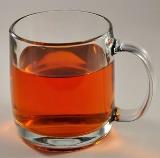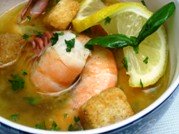|
Ocean Trace, Concentrated Sea Minerals, May Be The Best Fertilizer EverRevolutionize plant nutrition with trace ocean minerals from Ocean Trace. Getting trace minerals back into the plant helps restore health to a plant, and can result in less disease and fewer destructive sapping insects. However, perhaps the greatest impact of feeding your plants needed trace minerals is that it increases their nutrient density, and makes crops so delicious. A man had been giving his 80 year old neighbor squash from his garden for years. After fortifying his garden with Ocean Trace, he shared his squash with her. Her comment: “I know squash, and this is the best squash I ever ate”. Another woman, after tasting tomatoes from a garden rich in trace minerals, commented: “I haven’t tasted a tomato like this since I was a little girl”. Trace minerals, from Ocean Trace, really do make a huge difference in nutrition, and in taste. 
Sadly, over the last 70 years, modern farming methods which use chemical fertilizers have greatly depleted available trace minerals from our soils. Most soils have been reduced down from 74 minerals to 8 to 20. The best organic fertilizer may come from composting, applying manure and green teas, worm and bat droppings. However, these very good practices may not contain all the needed trace minerals as supplied by Ocean Trace. What then are the good sources for trace minerals? Fish, kelp, volcanic ash, humic acids, rock dust and sea minerals are all good. Of these, one of the most powerful ways to re-mineralize plants and soil is through low sodium, concentrated sea minerals. Liquid sea minerals are in ionic form, and are readily available to the plant. When Ocean Trace is sprayed on the leaf, sometimes it takes only 2 to 3 days before leaves turn a noticeably darker color of green. Sea minerals are also a great source of food for beneficial bacteria in the soil, thus strengthening the soil food chain.
A Brix reading, which can be measured with a Refractometer, measures the solids in the sap. This is comprised of both sugars and trace minerals. Higher Brix Means Healthier Plants - Trace minerals help to raise the brix, not just in sugar content but in trace mineral content of the sap, resulting in a healthier plant, less prone to disease. Higher Brix Means More Flavor - This is especially true when the plant is loaded with Trace Minerals. One of the most common testimonials we hear about Ocean Trace is from people who just can’t believe how good their fruits and vegetables taste when grown with concentrated sea minerals. Higher Brix Means Better Nutrition -Concentrated Sea Minerals not only increase the trace mineral content of the plant, but the vitamin content as well. A two year study was done in Montana, testing concentrated sea minerals on wheat. The results of the first year were almost identical to that of the second year. Growing wheat with concentrated sea minerals raised it’s vitamin content from 11% to 34%, depending on the vitamin tested. If you want to grow more nutritious foods, consider feeding them with a good trace mineral package. Higher Brix Means Longer Shelf Life - Consumers report that produce grown with Ocean Trace concentrated sea minerals has a shelf life 2 or 3 times as long as the same crop grown without it. This can be huge. Who likes eating wilted, rotten food?
Less Insect Pressure - Many farmers have reported that when they used concentrated sea minerals, their insect problems disappeared. For sure, sea minerals are NOT a pesticide. One reason for less insect pressure is that the potassium in sea minerals is a nutrient greatly needed by the plant. But it is also because the crop now has the perfect balance of micronutrients found in the Ocean. By helping to balance these micro-nutrients, plants become so much healthier. Sapping insects target sick plants. A sick plant, especially one without the proper cat ion exchange, will emit an infra-red signal that says to sapping insects, “dinner time”. But according to Tainio Technologies, when the hydrogen makeup of the plant is in balance with the cat ions, the insect no longer identifies the plant as food. Better Yields - Plants grown with Ocean Trace concentrated sea minerals generally yield better, if the plant has adequate moisture. This increase in yields may be as high as 10% to 17%, depending on the crop, the growing environment, and application rates. Less Fungus -A replicated study on peanuts was done with the University of Georgia on the effects of concentrated sea minerals on 2 fungus types, including white mold. This study demonstrated that peanuts had less fungus (and greater yields) than peanuts not fed with concentrated sea minerals. Concentrated sea minerals are not a fungicide. Decreased fungus can only be linked to better plant health. Ability to Promote Photosynthesis - Sea Minerals from Ocean Trace are a good source of Magnesium. It is the magnesium that within days can turn leaves to a darker, more even shade of green. There are numerous testimonials to this. (link to the testimonials page) The more photosynthesis, the more food the plant is able to manufacture, which can translate into greater yields. Animal Health - Dr. Maynard Murray did significant research with sea minerals. He documented his findings, which have been published in the book, “Sea Energy Agriculture, Nature's Ideal Trace Element Blend for Farm, Livestock, Humans”. In his many laboratory tests, animals that ate food grown fortified with sea minerals were injected with carcinogens to produce cancers, fed a diet that should result in hypertension, etc., etc. Incredibly enough, the animals that were fed a diet grown with sea minerals didn't get the cancer, the hypertension, etc., while the animals whose diet didn't include foods grown with sea minerals did. Could these same health benefits be experienced by humans as well. Sea Minerals, like those found in Ocean Trace, really are a key to improved health. Mineral Balance -Sea Minerals help to establish a good balance of trace minerals in the plant. This is very important. Trace minerals work together. One trace mineral is necessary for the plant to utilize other. So if a farmer just gives his crops a specific trace minerals, many times it will not be very available to the plant, because it doesn’t have the other trace minerals needed to utilize it. Therefore when a farmer loads his crops with Zinc, if it isn’t part of a balanced trace mineral application, his crop might not be able to utilize the zinc. What does the farmer do then? He just keeps putting on more zinc, hoping that his crops will get enough. The result is a zinc toxicity in the soil. Not a pretty thing. So having a balanced micronutrient program is so very helpful to both plants and soil. The Law of the Minimum - There are many trace minerals that are needed only in small amounts by the plant, but if the plant doesn’t have them, the plant will suffer. Concentrated sea minerals supply all 74 of the naturally occurring minerals on the Periodic Chart of Elements, and in a perfect ratio. It has been stated that both sap and blood plasma have almost the exact same ratios of trace minerals as ocean water. So when we apply a fertilizer which naturally has this perfect balance, it can be very beneficial. While it is true that most of these 74 minerals have not been acknowledged by the USDA as being needed by plants, every few years enough evidence is gathered to suggest that another of these minerals should be added to their list of "beneficial minerals". By giving a plant the full buffet of minerals found in the ocean, it is allowed to utilize the minerals it needs. Greater Soil Health -When the beneficial microbes in the soil thrive, the soil becomes healthier, and plants in turn become healthier. These microbes need trace minerals, and thrive when they are present. One manufacturer uses Ocean Trace concentrated sea minerals in his product designed to increase the number of microbes in the soil. He said that before adding sea minerals to his product, he could not achieve his goal of one billion microbes per square inch. But by adding Ocean Trace, he said he is now able to meet that goal.
|




